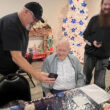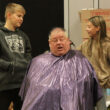Sean C. Morgan
Local emergency responder call loads continued at record levels in 2015, with the police responding to 10,161 calls and firefighter-medics responding to 2,699 calls.
It was the second-highest year ever for the Sweet Home Fire and Ambulance District, which set a record number of calls in 2014, with 2,792.
Sweet Home Police Department responded to a record number of calls, up from 9,665 in 2014. This includes code enforcement issues, which the department began handling in August 2013.
Not counting code enforcement complaints, the number of calls in 2015 set a new record for calls with 9,701. SHPD handled 460 code enforcement calls. The previous record number of calls, not counting code enforcement, was in 2005, with 9,547.
SHPD
“The first half of this year, we had a substantial increase in our call load,” said Police Chief Jeff Lynn. Through about August or September 2015, SHPD was on track to even higher numbers, but “we’ve kind of leveled off.”
The end of the year was less busy, he said, “I’d like it to drop a little bit lower.”
“I don’t think we’re going to look at anything different to handle the calls,” Lynn said. About halfway through 2015, the department filled a new school resource officer position in partnership with the Sweet Home School District.
Lynn believes that will help the department deal with its call load.
Right now, the department has 15 certified police officers, including the chief, two sergeants, a detective and the school resource officer.
The department’s annual report is set to be released this week, Lynn said. The report will include more details about crime in Sweet Home in 2015.
Among those details, he said, it will show a lower number of burglaries in 2015.
SHFAD
Of the SHFAD call load, 2,396 were medical calls while 303 were fire calls.
The call loads have remained consistent over the past year, and 2015 had nearly as many calls, said Fire Chief Dave Barringer, but since reorganization last year, the department has been able to handle the higher call loads better.
“We have 10 part-time employees who used to be called interns and resident volunteers,” Barringer said. The department had six interns and three volunteers prior to the change in 2015. Those 10 part-time employees work two at a time every fifth day.
“The shortest we are with manpower is four,” Barringer said. “The most fully staffed we are is five.”
Prior to this change, interns and volunteers may not be at the Fire Hall, Barringer said. They might be gone for a variety or reasons, such as going to school. Resident volunteers weren’t required to be at the Fire Hall. During those times, the Fire Hall might have as few as three medics available.
Before the new program, when down to three medics, the Fire Hall could fully staff one ambulance, responding with two medics aboard. The department would have to rely on calling back medics to fill the second ambulance.
Now, on a short shift, the Fire Hall can staff two ambulances before going to call back, Barringer said. At times, when the fire chief is in and a shift is full, the department can staff three ambulances. In many cases, the battalion chief on duty will follow the ambulance to a call to assist with moving a patient or to help provide treatment.
That extra person has decreased reliance on mutual aid from Lebanon Fire District for ambulance coverage, Barringer said. That’s at a time when Lebanon’s call loads are increasing.
Barringer said that Lebanon’s call loads have about doubled since 1996 when he worked there, but staffing levels haven’t changed, making it more difficult for Lebanon to provide ambulance coverage.
“I like where we’re going,” Barringer said. The department has been able to improve equipment, facilities and staffing the way it deserves to be safer.
He outlined a variety of in-house work provided by in-house experts, from Battalion Chief Guy Smith taking care of vehicle maintenance and repairs to Lt. Zach Lincoln leading improvements in the use of technology. Personnel have replaced siding at the Fire Hall. Battalion Chief Shannon Pettner is preparing information and plans for a proposed bond levy. Volunteers are making a difference across the board too, Ron Carter as a diver, Wes Strubhar as president of the volunteer association and Heather Harris with her work on a proposed building addition.
He said the volunteers are “experts” who simply keep him informed about what they’re doing and “run with it.”
“All I did was brush the surface,” Barringer said.




